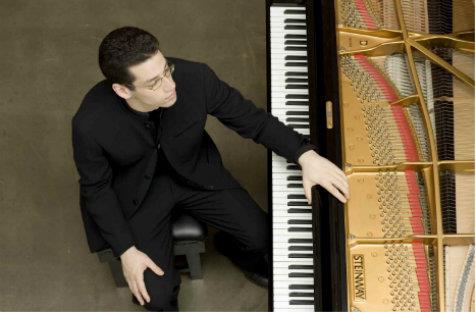It was a first, at least – the first time I’ve ever had a strong dislike of a musician. Jonathan Biss was the name of the pianistic malefactor who graced the Concert Hall platform with the Sydney Symphony. What was my problem with him, I hear you ask? What insult did he send my way? What sports team does he support that doesn’t agree with me? Which one of his ancestors pillaged the village of one of my ancestors? No – it was his gestures that I had a problem with.
Now, I feel I must let it be known that, until this point in time, I have been perfectly content with all manner of quirks and idiosyncrasies that musicians display when they’re on stage, save perhaps for bare feet. Indeed, this year alone I’ve seen, for instance, a female pianist who would fling her arm up at the end of a phrase and let it slowly fall like a part-time catatonic, as well as a male cellist who would audibly grunt along with some more passionate parts of the music. (That cellist, who performed Lutoslawksi’s cello concerto, was fantastic, by the way.) I’ve read commentators who bemoan the fact that soloists, pianists in particular, feel the need to be so dramatic and gesture-laden, and I’ve dismissed their complaints with a flick of the wrist and a ‘what does it matter, as long as the music sounds good?’ I stand (or sit) corrected. It does matter.
At the beginning of Mozart’s Piano Concerto No.22 in E flat, K482, as the orchestra was playing by themselves before the piano enters, Biss was moving along to the music – nothing wrong with that – then, hopefully silently, singing along with it too, his mouth making ‘pom-pom-pom’ shapes – perhaps a little bit disconcerting. And then, as he began to play, his manner, in effect, completely excluded me from the piece. While I’m sure that Biss is a lovely person, his on stage persona, for this night at least, struck me as extremely pompous. The way he would launch his arms into the air, the pseudo-sneer that he’d get on his face at times, the continual ‘pom-pom-pom’ accompaniment – it all grated on me, and continued to grate. What certainly didn’t help as well was that, rather unusually, the piano, sans lid, was dead-centre in front of the conductor, such that Biss was facing the stalls, and I, with my slightly off-centre seat in said stalls, had almost nowhere else to look without turning my head. Indeed, I even spent the entire second movement staring at my feet so that I might try and get a grapple on the emotional side of the music, but by then it was too late. Biss’ playing was technically sound, but I was about as uninvolved with the piece as it is possible to get,
Basically, the pianist seemed to be getting a lot more out of the concerto than I was. And I am shocked that I have succumbed to a complaint I previously thought ridiculous – it seems silly (immature, even) to have reacted so violently – but to say anything else would be misleading. The rest of the concert, however, was, thankfully, rather lovely.
It began with Bartok’s Divertimento for Strings, performed by the Australian Chamber Orchestra quite well a couple of months ago, but here given a new, and perhaps even more vital, life. (There certainly were more strings, though it was a bigger auditorium as well, the ACO performing in the City Recital Hall.) Conductor Antonello Manacorda – a very suave presence on stage, with a sense of highly focused enthusiasm – led the orchestra in an interpretation that was tightly elastic, with nary a loose moment. Careful with his attention to detail, he never let Bartok’s variety in the strings slip into monotony. It was a polished and continually engaging performance.
The same can’t quite be said for the symphony on the program, Dvorak’s Symphony No.8 in G, B163 (Op.88). Here Manacorda and the orchestra felt a tad more diffuse in their rendering, particularly noticeable after the Mahler Chamber Orchestra’s magnificent rendering of Dvorak’s evergreen ninth symphony last month. This concert, then, ran the full and prickly gamut of experience, from the complete detachment of the concerto to the intense involvement of the Bartok, with the pleasant outing of the Dvorak to cap the evening. Manacorda is a thoroughly interesting conductor, but one’s memories, unfortunately, were somewhat overwhelmed by the man in front of the podium.
Rating: 3 ½ stars out of 5
Bohemian Adventure
Sydney Symphony
Antonello Manacorda – conductor
Jonathan Biss – piano
Bela Bartok – Divertimento for Strings
Wolfgang Amadeus Mozart – Piano Concerto No.22 in E flat, K482
Antonin Dvorak – Symphony No8 in G, B163 (Op.88)
Concert Hall, Sydney Opera House
26 July





